Table of Contents
Attention
Attention is what separates static embeddings from dynamic embeddings - they allow word embeddings to be updated, aka attended to, by the contextual words surrounding them
Attention stemmed from NLP Seq2Seq Tasks like next word prediction, and translation where using the surrounding context of the word was one of the major breakthroughs in achieving better Seq2Seq results
We need to remember that the embedding for “bank” is always the same Embedding in the Metric Space in these scenario’s, but by attending to it with Attention, we can change it’s position! It’s as simple as that, so at the end of attending to the vector, the vector for bank in river bank may point in a completely different direction than the vector for bank in bank vault - just because of how the other words add or detract from it geometrically in its Metric Space. Bank + having river in sentence moves vector in matrix space closer to a sand dune, where Bank + teller in sentence moves it closer to a financial worker
How is this done? Attention mechanisms in our DNN models. There are multiple forms of Attention including Self Attention, Encoder-Decoder Attention, and Bahdanau Attention - each of them help to attend to a current query word / position based on it’s surroundings. A single head of this Attention mechanism would only update certain “relationships”, or attended to geometric shifts, but mutliple different Attention mechanisms might be able to learn a dynamic range of relationships
All of these Attention mechanisms are tunable matrices of weights - they are learned and updated through the model training process, and it’s why we need to “bring along the model” during inference…otherwise we can’t use the Attention!
Encoding Blocks
The main layer we focus on in our Encoding blocks is Self Attention, but alongside this there are other linear layers that help to stabilize our context creation
Self Attention
Self Attention allows words in a single sentence / document to attend to each other to update word embeddings in itself. It’s most commonly used when we want a sentence’s word embeddings to be updated by other words in the same sentence, but there’s nothing stopping us from using it over an entire document.
It was born out of the example of desiring a different embedding outcome of the word bank in:
- The river bank was dirty
- I went to the bank to deposit money
Via Self Attention, the word “bank” in the two sentences above would be different, because the other words in the sentence “attended to” it
Self Attention is a mechanism that uses context words (Keys) to update the embedding of a current word (Query). It allows embeddings to dynamically adjust based on their surrounding context.
Example
Consider the phrase “fluffy blue creature.” The embedding for “creature” is updated by attending to “fluffy” and “blue,” which contribute the most to its contextual meaning.
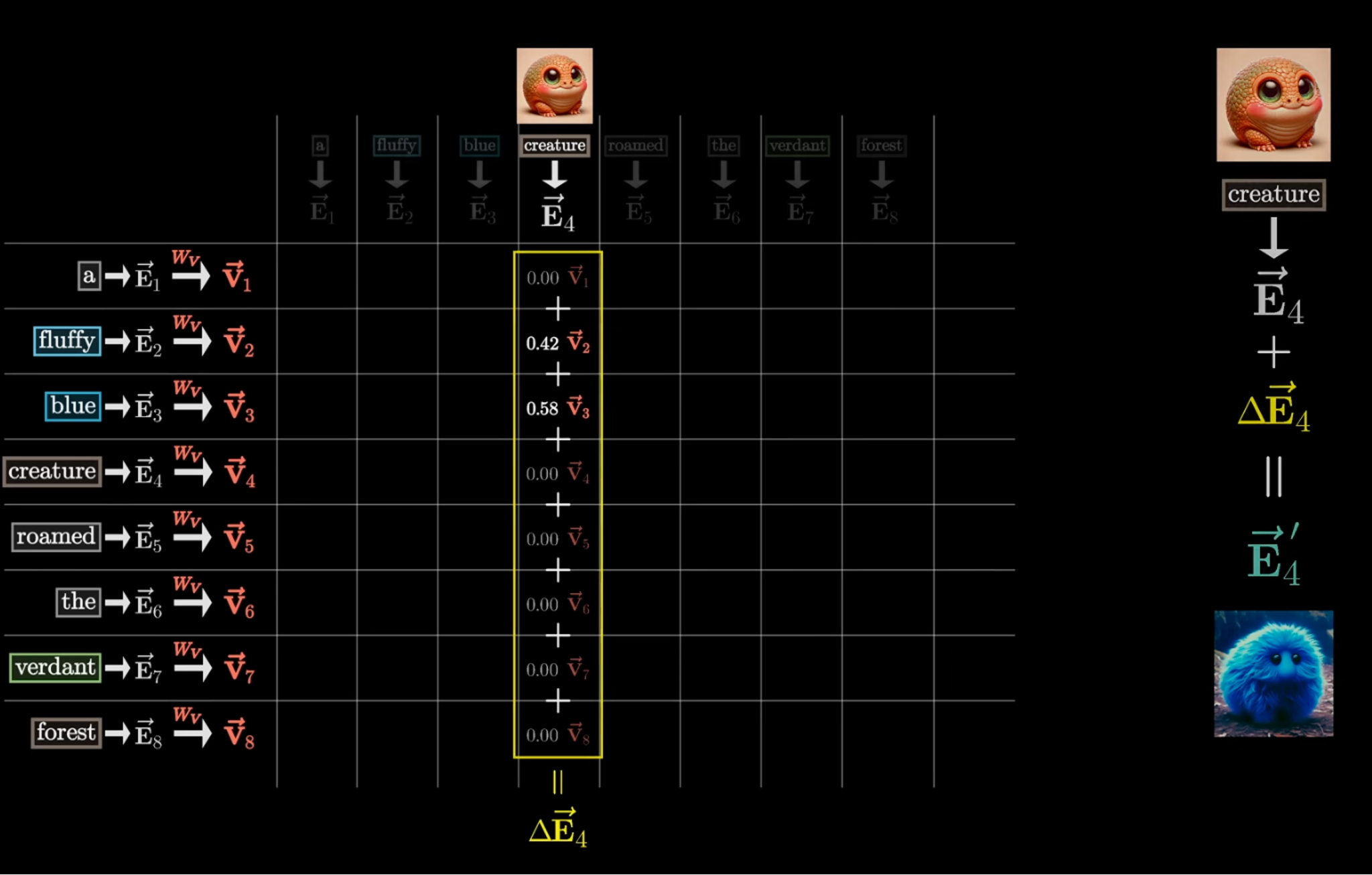
Key, Query, and Value Matrices
- Query (Q):
- Represents the word being attended to
- Used to calculate attention scores with all Keys
- Key (K):
- Represents the context words being compared to the Query
- Used to compute the relevance of each context word to the Query
- Value (V):
- Another representation of the context words, but separate and different from Keys
- Although the same input context words are multiplied by 2 different K, V matrices, which results in 2 different Key and Value vectors for same context word
- It basically is a representation of each “word” so at the end, a scored
SUM()of all words is over values! - Weighted by the attention scores to produce the final output
- Another representation of the context words, but separate and different from Keys
These matrices are learned during training and updated via backpropagation
How Self Attention Works
TLDR;
- The Query vector $Q_i$ represents the current word
- The Key vector is an embedding representing every other word $K_j \forall {j \neq i} $
- We multiply the Query by every Key to find out how “similar”, or “attended to” each Query should be by each Key $Q_i \cdot K_j$
- Then we softmax it to find the percentage each Key should have on the Query
- Finally we multiply that softmaxed representation by the Value vector, which is the input embedding multipled by Value matrix, and ultimately allow each Key context word to attend to our Query by some percentage
-
At the end, we sum together all of the resulting value vectors, and this resulting SUM of weighted value vectors is our attended to output embedding
- In the below example:
- The dark blue vector from the left is the Query
- The light blue vector on top are the Keys
- We multiple them together + softmax
- Multiply the result of that by each Value vector on the bottom

In depth mathematical explanation below
- Input Transformation:
- Each input embedding ( x_i ) is transformed into three vectors: Query (Q), Key (K), and Value (V)
- These are computed by multiplying the input embedding with learned weight matrices:
[
q_i = x_i \cdot W_Q, \quad k_i = x_i \cdot W_K, \quad v_i = x_i \cdot W_V
]
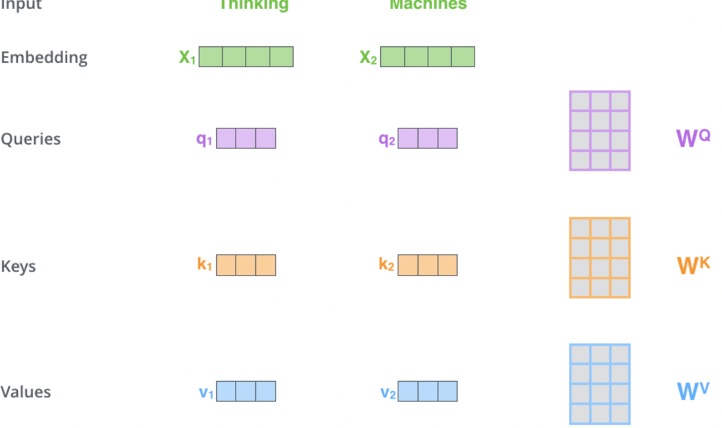
- Self-Attention Calculation:
- Step 1: Compute attention scores by taking the dot product of the Query vector ( q_i ) with all Key vectors ( k_j ): [ \text{Score}_{ij} = q_i \cdot k_j ]
- Step 2: Scale the scores to prevent large values: [ \text{Scaled Score}{ij} = \frac{\text{Score}{ij}}{\sqrt{d_k}} ]
- Where ( d_k ) is the dimensionality of the Key vectors
- As the size of the input embedding grows, so does the average size of the dot product that produces the weights
- Remember dot product is a scalar value
- Grows by a factor of $\sqrt{d_k}$ where k = num dimensions
- Therefore, we can counteract this by normalizing is via $\sqrt{d_k}$ as the denominator
- Step 3: Apply softmax to convert scores into probabilities: [ \text{Attention Weight}{ij} = \text{softmax}(\text{Scaled Score}{ij}) ]
- Step 4: Compute the weighted sum of Value vectors:
[
Z_i = \sum_j \text{Attention Weight}_{ij} \cdot V_j
]
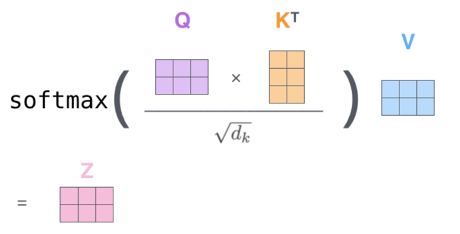
- Output:
- The output ( Z_i ) is a context-aware representation of the word ( i ), influenced by its relationship with other words in the sequence.
Multi-Head Attention
- Instead of using a single set of ( Q, K, V ), Multi-Head Attention uses multiple sets to capture different types of relationships between words (e.g., syntactic vs. semantic).
- Each head computes its own attention output.
- Outputs from all heads are concatenated and passed through a final weight matrix ( W_O ):
[
Z = \text{Concat}(O^{(head_1)}, O^{(head_2)}, \dots) \cdot W_O
]
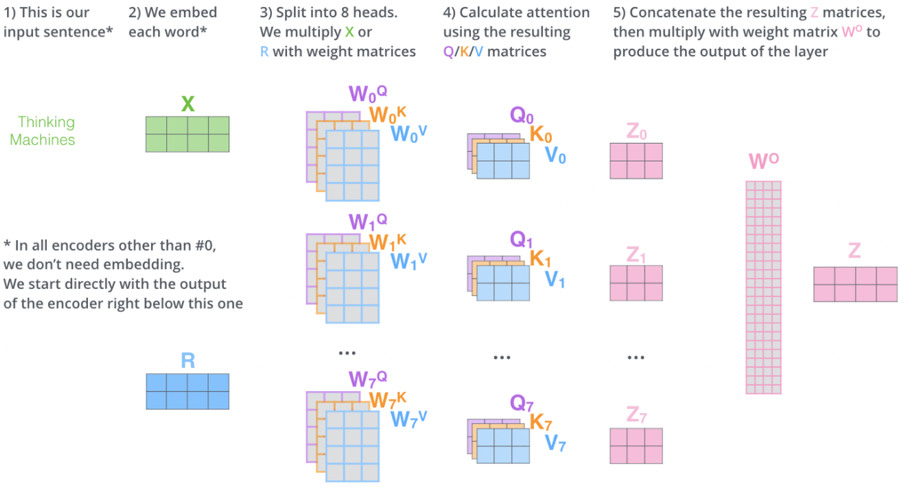
- Outputs from all heads are concatenated and passed through a final weight matrix ( W_O ):
[
Z = \text{Concat}(O^{(head_1)}, O^{(head_2)}, \dots) \cdot W_O
]
Positional Encoding
- Since Self Attention does not inherently consider word order, Positional Encoding is added to input embeddings to encode word positions
- Positional encodings are vectors added to each input embedding, allowing the model to distinguish between words based on their positions in the sequence
- Why is **sinusoidal relevant and useful?**
- Allows Transformer to learn relative positions via linear functions (e.g., $\text PE_{pos+k}$ can be derived from $\text PE_{pos}$)
- We all know neural nets like linear functions! So it’s helpful in ensuring a relationship that’s understandable
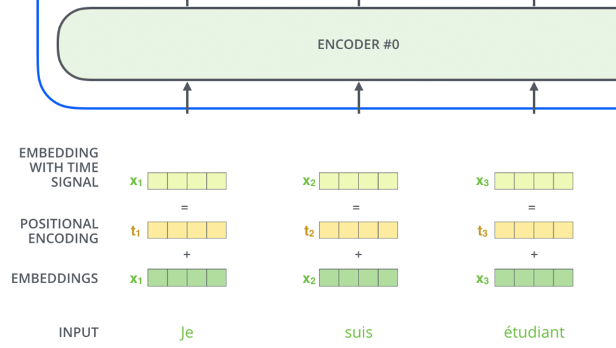
Residual Connections and Normalization
- Each encoder layer includes a residual connection and normalization layers to stabilize training and improve gradient flow
- This happens after both Self Attention Layer and Feed Forward Layer in the “Add and Normalize” bubble
- Add the residual (the original input for that sublayer) to the output of the sublayer
- In the case of Self Attention layer, we add the output of Self Attention to the original input word (non-attended to word)
- Apply LayerNorm to the result
- This just means normalize all actual numeric values over the words embedding
- **If the diagram shows a block over the whole sentence, it just means the operation is applied to all words, but always independently for each word
- Why is any of this useful:
- Helps with gradient vanishing and exploding, and also ensures input stability
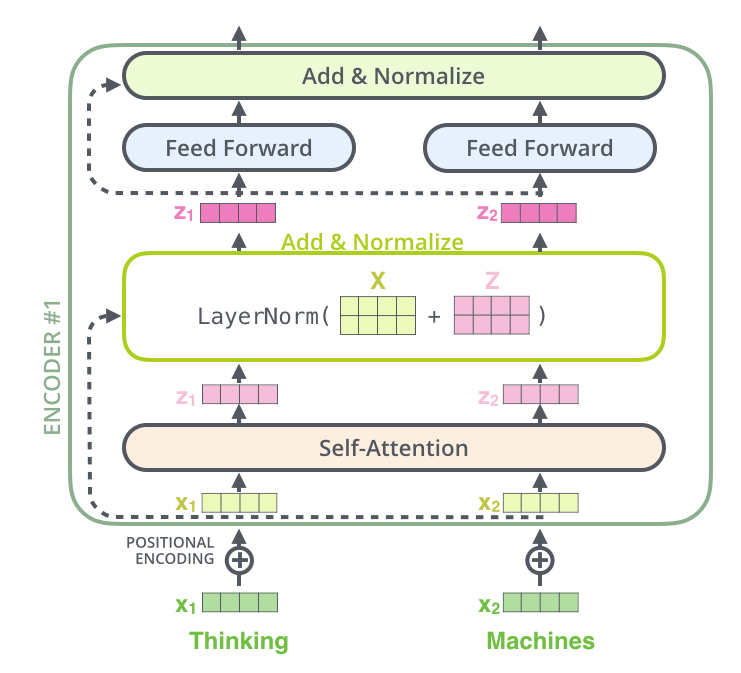
Summary of Self Attention Encoding
- Input Embedings:
- We take our input words, process them, and retrieve static embeddings
- This only happens in the first encoding layer
- Positional Encoding:
- Add positional information to embeddings to account for word order
- Self Attention:
3.1 Input Transformation:
- Positionally encoded embeddings are transformed into ( Q, K, V ) using learned weight matrices.
3.2 Self Attention Calculation:
- Compute attention scores using dot products of ( Q ) and ( K ), scale them, and apply softmax.
3.3 Weighted Sum:
- Use the attention weights to compute a weighted sum of ( V ), and add that onto the input word, producing the output.
3.4 Residual + Normalization:
- LayerNorm add together input and self-attended to matrices
3.5 Feed Forward Layer:
- Each position’s output from the self-attention layer is passed through a fully connected feed-forward neural network (the same network is applied independently to each position)
- Essentially just gives model another chance to find and model more transformations / features, while also potentially allowing different dimensionalities to be stacked together
- If we have 10 words in our input, we want to ensure the final output is the same dimensionality as the input
- I don’t know if this is exactly necessary
4 Multi-Head Attention:
- Use multiple sets of ( Q, K, V ) to capture diverse relationships, then concatenate the results.
This diagram below shows one single encoding block using Self Attention

Masked Self Attention
- In Masked Self Attention, it’s the same process as Self Attention except we mask a certain number of words so that the ( Q \cdot K ) results in 0 effectively removing it from attention scoring
- In BERT training we mask a number of words inside of the sentence
- In GPT2 training we mask all future words (right hand of sentence from any word)
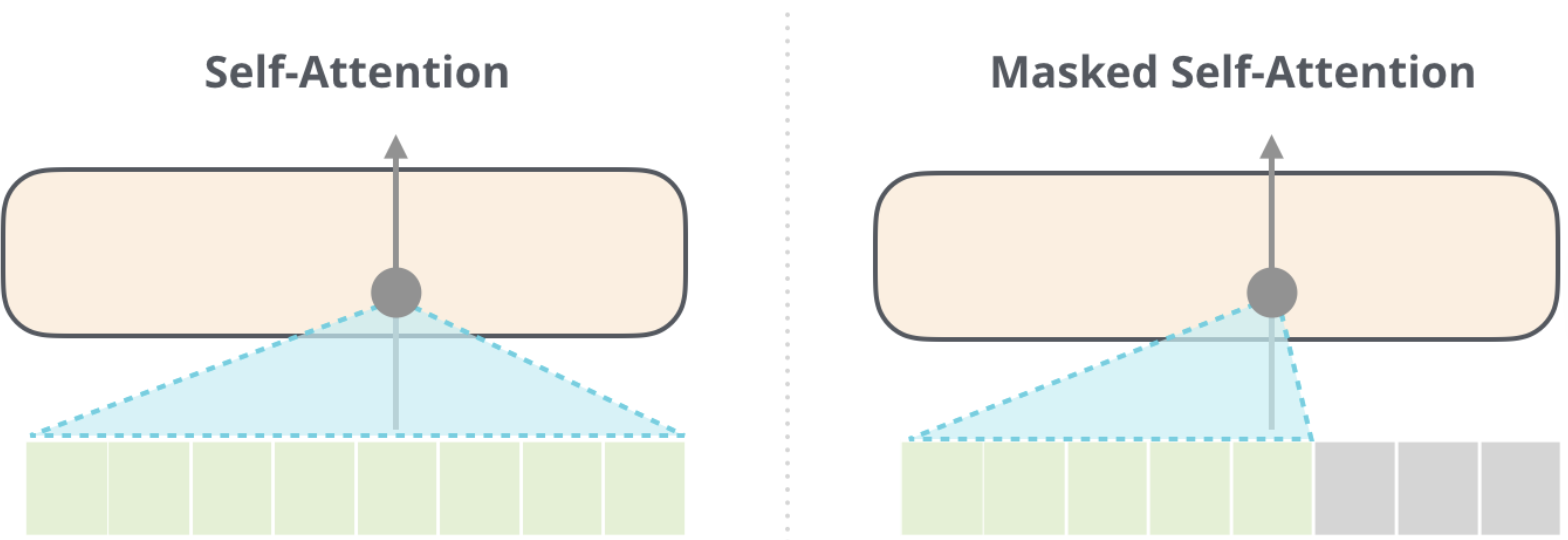
Context Size and Scaling Challenges
- The size of the ( Q \cdot K ) matrix grows quadratically with the context size (( n^2 )), making it computationally expensive for long sequences.
- To address this, masking is used to prevent future words from influencing current words during training (e.g., in autoregressive tasks).
- Context size
- Size of Q * K matrix at the end is the square of the context size, since we need to use all of the Q * K vectors, and…it’s a matrix! So it’s n*n = n^2 so it’s very hard to scale
- It does help that we mask ½ the examples because we don’t want future words to alter our current word and have it cheat
- Since for an entire sentence during training for each word we try to predict the next, so if there are 5 words there’s 1, 2, 3, 4, 5 training examples and not just 1
- Don’t want 4 and 5 to interfere with training 1, 2, 3
Encoder-Decoder Attention
Encoder-Decoder Attention is a mechanism used in Seq2Seq tasks (e.g., translation, summarization) to transform an input sequence into an output sequence. It combines Self Attention within the encoder and decoder blocks each, and then cross-attention between the encoder and decoder
How Encoder-Decoder Attention Works
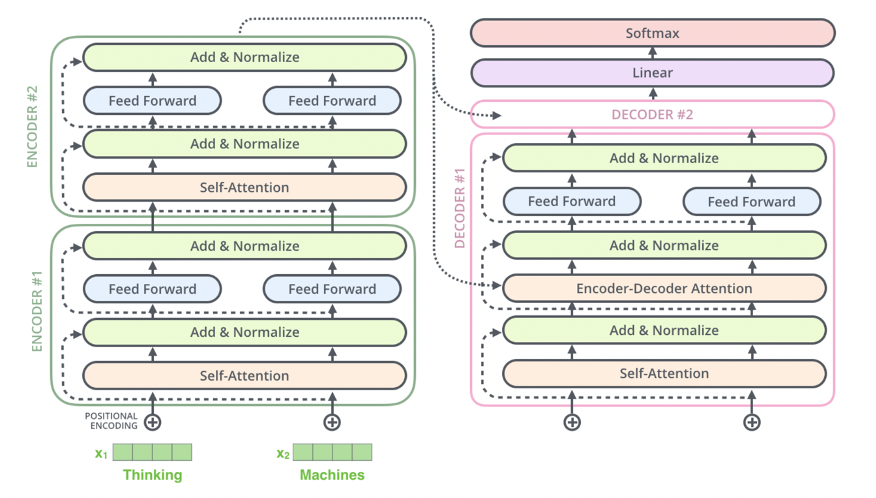
- Encoder:
- The Encoder Portion is completely described by what we wrote above in Summary of Self Attention Encoding
- TLDR;
- The encoder processes the input sequence and generates a sequence of hidden states that represent the context of the input
- Each encoder block consists of:
- Input Embedding:
- The first encoding layer typically uses positional encoding + static embeddings from Word2Vec or GLoVE
- Self Attention Layer:
- Allows each token in the input sequence to attend to other tokens in the sequence
- This captures relationships between tokens in the input
- Feed Forward Layer:
- Applies a fully connected feed-forward network to each token independently
- Typically two linear transformations with a ReLU/GeLU in between:
FFN(x) = max(0, xW₁ + b₁)W₂ + b₂
- Residual Connection + LayerNorm
- Add input / output of layer, and then normalize across vector
- Input Embedding:
- The output of each encoder block is passed to the next encoder block as input, and the final encoder block produces the contextual embeddings for the entire input sequence
- These are further transformed into K, V contextual output embeddings
- This confused me at first, but basically the output of an encoder block is same dimensionality as word embedding input, so it can flow through
- This is usually known as
d_model- This allows us to stack encoder blocks arbitrarily
- Architecture:
- Composed of multiple identical blocks (e.g., 6 blocks by default, but this is a hyperparameter)
- Each block contains:
- Self Attention Layer: Captures relationships within the input sequence
- Feed Forward Layer: Processes each token independently

- Decoder:

- The decoder generates the output sequence one token at a time, using both the encoder’s output and its own previous outputs
- Input:
- The contextual embeddings output from the final Encoding Layer
- These K, V contextual output embeddings are passed to each Decoder block
- The previous Decoder block(s) output (previously generated word)
- The contextual embeddings output from the final Encoding Layer
- Each decoder block consists of:
- Masked Self Attention Layer:
- Allows each token in the output sequence to attend to previously generated tokens in the sequence (auto-regressive behavior)
- Future tokens are masked to prevent the model from “cheating” by looking ahead
- So self-attention only happens from words on the left, not all Keys
- Query: Special Start Token
- Key and Values: All already generated words to the Left
- Encoder-Decoder Attention Layer:
- Attends to the encoder’s output (contextual embeddings) to incorporate information from the input sequence
- Query: Comes from the decoder’s self-attention output
- Key and Values: Come from the encoder’s output
- Feed Forward Layer:
- Applies a fully connected feed-forward network to each token independently
- Architecture:
- Applies a fully connected feed-forward network to each token independently
- Masked Self Attention Layer:
- Composed of multiple identical blocks (e.g., 6 blocks by default).
- Each block contains:
- Self Attention Layer: Captures relationships within the output sequence
- Encoder-Decoder Attention Layer: Incorporates information from the encoder’s output
- Feed Forward Layer: Processes each token independently
- Example:
- Third word in the decoder output, meaning the first two have already been generated
- Decoder Self Attention
- Input: The embeddings for the first, second, and third generated tokens so far
- For the third position, it uses a special start-of-sequence token or the previously generated tokens as input
- It does not have the embedding for the third word yet—because it hasn’t generated it!
- Masking: The self-attention is masked so the third position can only “see” the first, second, and third tokens (not future tokens)
- Q, K, V:
- For the third position, the query is the embedding of the third word
- The keys and values are the embeddings of the first, second, and third tokens
- What happens: The third token attends to itself and all previous tokens (but not future ones), using their embeddings as keys and values
- Input: The embeddings for the first, second, and third generated tokens so far
- Encoder Decoder Cross Attention
- Input: The output of the decoder’s self-attention for the third token (now a context-aware vector), and the encoder’s output for all input tokens
- Q, K, V:
- The query is the third word’s vector (after self-attention and residual/LayerNorm)
- The keys and values are the encoder’s output vectors for each input token (these are fixed for the whole output sequence)
- What happens: The third token’s representation attends to all positions in the input sequence, using the encoder’s outputs as keys and values
- Final Decoder Output:
- The final decoder layer produces a vector of floats for each token, which is passed through:
- A linear layer to expand the vector to the vocabulary size
- A softmax layer to produce a probability distribution over the vocabulary for the next token
- The final decoder layer produces a vector of floats for each token, which is passed through:
Visual Representation
- Encoder Block:
- Self Attention → Feed Forward → Output to next encoder block.
- Decoder Block:
- Self Attention → Encoder-Decoder Attention → Feed Forward → Output to next decoder block.
- Final Decoder Output:
- The final decoder output is passed through a linear layer and softmax to produce the next token.
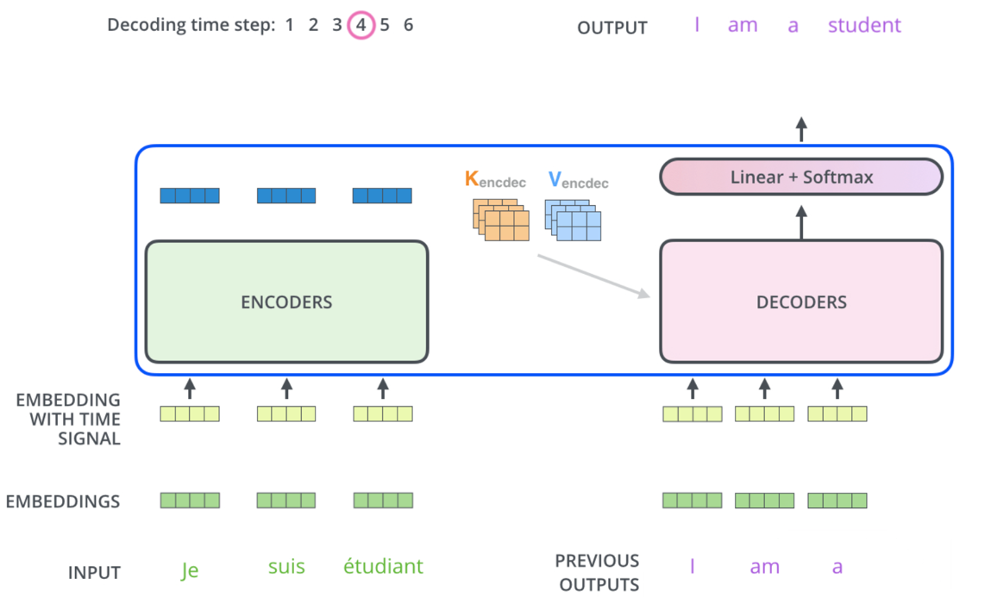
- The final decoder output is passed through a linear layer and softmax to produce the next token.
Summary of Encoder-Decoder Attention
- Encoder:
- Processes the input sequence and generates contextual embeddings using self-attention.
- Decoder:
- Generates the output sequence token by token using:
- Self Attention: Captures relationships within the output sequence.
- Encoder-Decoder Attention: Incorporates information from the input sequence.
- Generates the output sequence token by token using:
- Final Output:
- The decoder’s output is passed through a linear layer and softmax to produce the next token.
- Training:
- The model is trained using cross-entropy loss and KL divergence, with each token in the output sequence contributing to the loss.
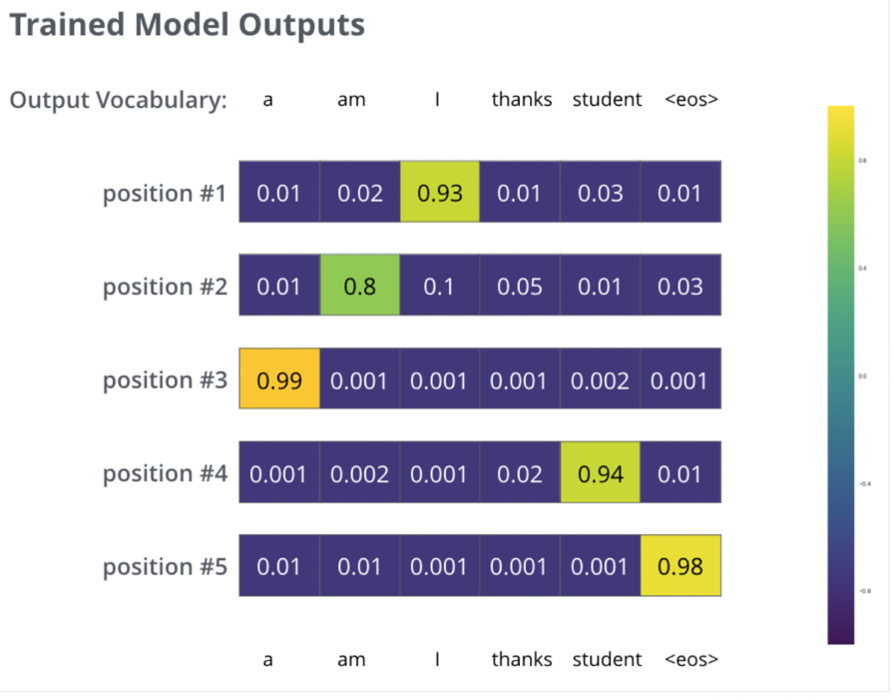
- The model is trained using cross-entropy loss and KL divergence, with each token in the output sequence contributing to the loss.
